The term Seebeck Power generation has been coined from the Seebeck effect which states that when electricity is created between a thermocouple when the ends are subjected to a temperature difference between them.
In layman’s terms, it is based on a phenomenon in which a temperature difference between two dissimilar electrical conductors or semiconductors produces a voltage difference between the two substances. Whenever heat is applied to one of the two conductors or semiconductors, the excited electrons flow towards the cooler conductor or semiconductor. Now suppose the pair is connected through an electrical circuit, and direct current (DC) flows through that circuit.
Seebeck Power Generation is also termed as Thermoelectric Power Generation because a loop of dissimilar metals will develop an emf if the two junctions are kept at different temperatures. This principle is already used in thermocouples for the measurement of temperature. However, with the recent developments, it has become possible that thermoelectric generators of a few KW sizes can be used for experimental purposes.
Thermoelectric Power Generator
Thermo-Generators are devices that convert temperature differential heat directly into electrical energy. These are called solid-state devices and have no moving parts, unlike dynamos. The principle of thermoelectric generation can be shown in the below figure where electrodes I and II are bridged at the hot junction and are connected to the output terminals at the cold junction. The hot junction is maintained at a high temperature by concentrating sun rays on it. By water cooling, the cold junction is kept cold. Now with the setup, the electric current is set up due to the difference in temperatures of hot and cold junctions and completes its path through the external load circuit.
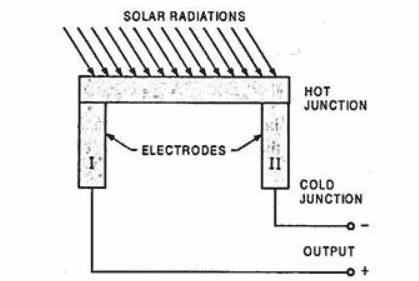
Mostly it is based on the direct conversion of heat into electric power but its efficiency is quite low (1 to 3%). Semiconductor materials are on focus to be used as substitutes.
How to increase power of Thermoelectric Generator?
The voltage and electrical power output can be increased by increasing the temperature difference between hot and cold ends. Therefore, in order to achieve a higher potential difference, many generators must be connected in parallel. For increasing the useful power output, parallel and series connections are used as shown in the below figures.
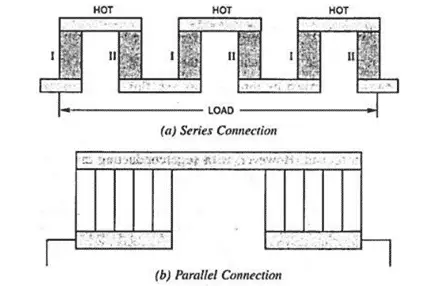
The direct current generated can then be converted into alternating current by using an inverter.
Thermoelectric generators are usually built with power outputs ranging from a few watts to kilowatts.
Semiconductors being good thermal insulators can be used as a basis for thermal converter designs capable of withstanding large temperature gradients and hence generating greater thermos EMFs. Semiconductor materials like lead telluride, zinc antimonite, and germanium silicide produce power with an efficiency of around 10%.
Liquid semiconductors can also be used but their main drawback is that the rate of heat transfer from the hot to the cold junction is increased by convection.
The main advantages of thermos electric generators are the absence of moving or rotating parts and the non-involvement of high pressures. They are readily serviceable and quiet in operation and are widely employed as power sources on space- crafts, missiles, beacons, etc.
The main disadvantages of thermos-electric generators are high cost, low efficiency, and low outputs.
Applications of Thermoelectric Power Generation
- Thermoelectric fuel elements in Nuclear Reactor
The thermoelectric generator is also incorporated into the fuel elements of a nuclear reactor which will help in obtaining large power outputs. - Thermoelectric waste heat stack
The thermoelectric generator can be used to generate electricity using waste heat from gas turbines, diesel engines, and stack gases. A metal stack consists of a series of rings of two alternate metals connected at the inner and outer annular edges alternately with the rings electrically and thermally insulated. - Decay heat of Radioactive Isotopes
An important application is the generation of power in space and other remote locations by using radioactive decay heat. The decay heat of radioisotopes is used for the operation of small(0.1kW) thermoelectric generators. Also, remote generators for signaling are used based on heat decay of Strontium 85.
Working of a Thermoelectric Power Generator
Let us consider a Thermoelectric power generator having a heat source at one end and a heat sink at the other end with the heat source being relatively at a higher temperature than that of the heat sink. Suppose the temperature difference is ΔT. The applied heat to the hot junction causes the electrons and holes in the n-type and p-type block respectively to flow away from the heat junction and thereby producing an electrical potential difference. The circuit can be completed by connecting a load resistance, RL. The current will start flowing through this resistance RL.
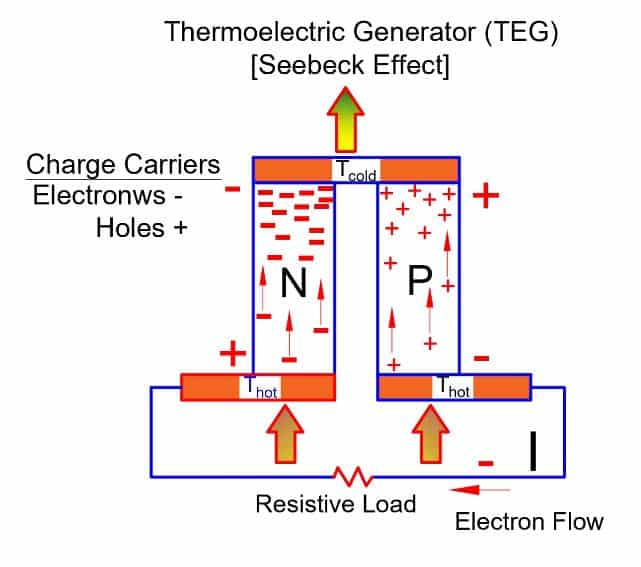
The voltage generated can be given as V = α ΔT, where α is the Seebeck coefficient and ΔT is the temperature difference between hot and cold junction.
If we consider R to be the internal resistance of the thermoelectric generator then the current flowing through the load is;

Substituting the value of V in the above equation we get current,

The power flow to the load is;
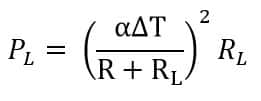
The maximum power output is when R = RL
Therefore, maximum power output is;
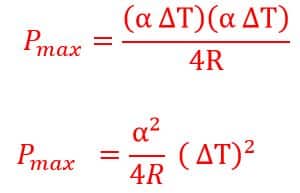
In Seebeck Power generation, the term (α2/R) is called the figure of merit. Therefore, for the power to be maximum we need the ΔT and figure of merit to be maximum. And for the figure of merit to be maximum, we need low internal resistance which can be achieved by decreasing the length and increasing the diameter. And, ΔT can be increased by increasing the temperature difference between the heat source and heat sink.
Efficiency of Thermoelectric Power Generator
The ratio of power developed, PL across the load resistance RL to the heat flow is the efficiency of thermoelectric power generation.
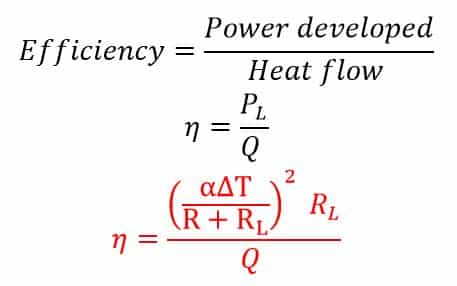
Materials for Thermoelectric Power Generators
The lead telluride (PbTe) is the most common material for thermoelectric generators. Lead telluride is a compound of lead and tellurium which have a small amount of bismuth((Bi2Te3) or sodium. Other thermoelectric compounds are bismuth telluride, bismuth sulfide, germanium telluride, zinc antimonite, tin telluride, Silicon germanium (SiGe), indium arsenide, etc.
Many thermoelectric generator materials are currently undergoing research.
Advantages of Thermoelectric Generators
- Reliability – Thermoelectric generators are very reliable because they do not have moving parts. Thermoelectric generators can last a very long time.
- Quiet – Thermoelectric generators can be designed to be completely silent. There is no noise pollution with the use of thermoelectric generators.
- Green energy – Thermoelectric generators do not require any gases to operate which are harmful to the environment.
- Wide Range of Fuel Sources – Thermoelectric generators can work with heat sources of any kind.
- Scalability – It is possible to design the thermoelectric generators in the power range of microwatts to kilowatts.
- Mountable in Any Orientation – Unlike other generator technology, thermoelectric generators operate in any orientation.
- Operation Under high and Zero G-forces – Thermoelectric generators have the capability to operate under zero gravitation or high gravitation conditions. Whereas, some other energy conversion technologies cannot.
- Direct Energy Conversion – The conventional generators do not directly convert one source of energy to electrical energy. They first convert the energy from one to another source and then converts intermediate energy into electricity. This is not the case with thermoelectric generators. The thermoelectric generators directly convert heat into electricity.
- Compact Size – Thermoelectric generators are very compact because of the simplicity of design and fewer parts. This leads to greater design flexibility.
Limitations of Thermoelectric Power Generators
- When we connect several thermoelectric generators in series to get high voltage, the effective resistance increase. This cause problem in transferring the power from the source to the load end. This problem can be rectified by the use of parallel connections of thermoelectric elements. When elements connected in the parallel offer low resistance.
- The efficiency of the thermoelectric power generators is poor as compared to other mechanical generators. It produces less electric power for the same heat flow.
- The thermoelectric generators have low thermal conductivity and thus have very poor heat dissipation. These generators are suitable for small power generation.
- Thermoelectric generators are costlier than the other generators.
Major Types of Thermoelectric Generators
Fossil -Fuel generators
These generators use natural gas, propane, butane, kerosene, jet fuels, and wood as heat sources. It can generate power in the range of 1-100 watts.
Solar-source Generators
Utilizing solar heat from the Sun-oriented side of the spacecraft, thermoelectric devices can generate electrical power for use by other thermoelectric devices in dark areas of the spacecraft and dissipate heat from the vehicle.
Nuclear-fueled generators
The generators use decay products of radioactive isotopes to provide a high-temperature heat source for thermoelectric generators.
Read Next: